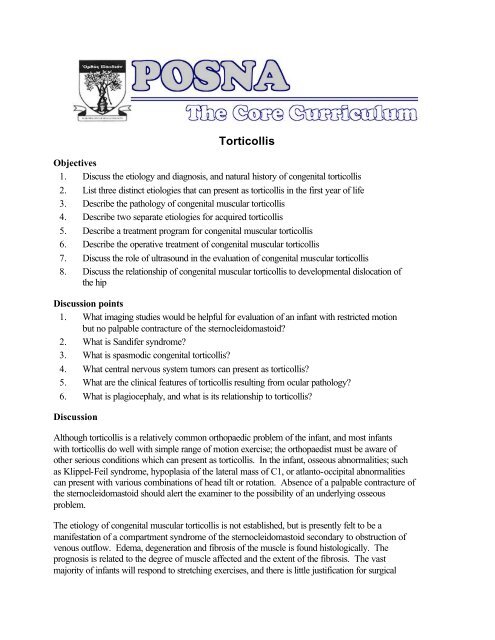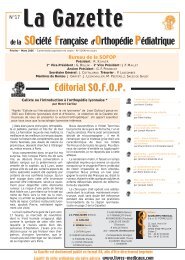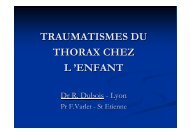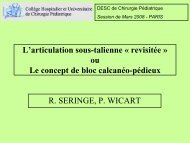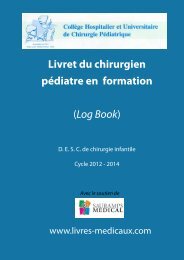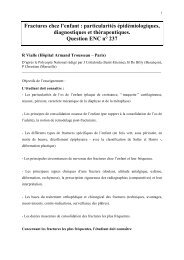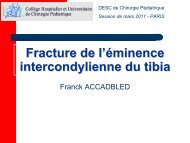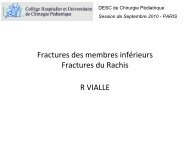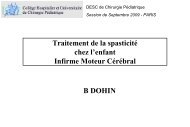Torticollis - SOFOP
Torticollis - SOFOP
Torticollis - SOFOP
- No tags were found...
Create successful ePaper yourself
Turn your PDF publications into a flip-book with our unique Google optimized e-Paper software.
<strong>Torticollis</strong>Objectives1. Discuss the etiology and diagnosis, and natural history of congenital torticollis2. List three distinct etiologies that can present as torticollis in the first year of life3. Describe the pathology of congenital muscular torticollis4. Describe two separate etiologies for acquired torticollis5. Describe a treatment program for congenital muscular torticollis6. Describe the operative treatment of congenital muscular torticollis7. Discuss the role of ultrasound in the evaluation of congenital muscular torticollis8. Discuss the relationship of congenital muscular torticollis to developmental dislocation ofthe hipDiscussion points1. What imaging studies would be helpful for evaluation of an infant with restricted motionbut no palpable contracture of the sternocleidomastoid?2. What is Sandifer syndrome?3. What is spasmodic congenital torticollis?4. What central nervous system tumors can present as torticollis?5. What are the clinical features of torticollis resulting from ocular pathology?6. What is plagiocephaly, and what is its relationship to torticollis?DiscussionAlthough torticollis is a relatively common orthopaedic problem of the infant, and most infantswith torticollis do well with simple range of motion exercise; the orthopaedist must be aware ofother serious conditions which can present as torticollis. In the infant, osseous abnormalities; suchas Klippel-Feil syndrome, hypoplasia of the lateral mass of C1, or atlanto-occipital abnormalitiescan present with various combinations of head tilt or rotation. Absence of a palpable contracture ofthe sternocleidomastoid should alert the examiner to the possibility of an underlying osseousproblem.The etiology of congenital muscular torticollis is not established, but is presently felt to be amanifestation of a compartment syndrome of the sternocleidomastoid secondary to obstruction ofvenous outflow. Edema, degeneration and fibrosis of the muscle is found histologically. Theprognosis is related to the degree of muscle affected and the extent of the fibrosis. The vastmajority of infants will respond to stretching exercises, and there is little justification for surgical
elease before at least 12 months of age. An association of congenital torticollis withdevelopmental dislocation of the hip has been noted, with an incidence of co-existence of theseentities up to 20% reported, but a recent report indicates the actual incidence may be much lower.Contractures of the hip and plagiocephaly (skull and face molding) commonly accompanycongenital muscular torticollis. These conditions may result from intrauterine positioning orsubsequent postural habits. Plagiocephaly is often of greatest concern to families, and probably is aresult of habitually sleeping with the head on the same side.The results of surgical release are good, even with older children, although remodeling ofplagiocephaly will obviously be slower in older children. Bipolar release of thesternocleidomastoid seems to be presently favored, but good results are also attainable afterunipolar release. Endoscopic division has also been reported.Sandifer syndrome is characterized by gastroesophageal reflux and torticollis or tilting of the head,presumably an attempt on the child to be more comfortable. It may present in infancy or laterchildhood, usually in children with cerebral palsy.Atypical torticollis may also be a presentation of neurogenic tumors of malformations, of whichposterior fossa lesions are most common. Ocular dysfunction can also cause tilting of the headwhich can appear as torticollis. With ocular dysfunction, tilting the head should produce adifference in tilt as the child attempts to preserve binocularity.Paroxysmal torticollis is an unusual self-limiting condition consisting of intermittent spasms of thesternocleidomastoid, often sproradically involving both sides. Treatment is ineffective and itusually resolves by age 2 or 3.Atlanto-axial subluxation is a cause of torticollis in older children, and is discussed separately.References1. Ballock RT, Song KM. The prevalence of nonmuscular causes of torticollis in children.Journal of Pediatric Orthopedics 1996;16(4):500-4.2. Bratt HD, Menelaus MB. Benign paroxysmal torticollis of infancy. Journal of Bone & JointSurgery - British Volume 1992;74(3):449-51.3. Brougham DI, Cole WG, Dickens DR, Menelaus MB. <strong>Torticollis</strong> due to a combination ofsternomastoid contracture and congenital vertebral anomalies. Journal of Bone & Joint Surgery -British Volume 1989;71(3):404-7.4. Burstein FD, Cohen SR. Endoscopic surgical treatment for congenital muscular torticollis[see comments]. Plastic & Reconstructive Surgery 1998;101(1):20-4; discussion 5-6.5. Chen CE, Ko JY. Surgical treatment of muscular torticollis for patients above 6 years ofage. Archives of Orthopaedic & Trauma Surgery 2000;120(3-4):149-51.6. Cheng JC, Au AW. Infantile torticollis: a review of 624 cases. Journal of PediatricOrthopedics 1994;14(6):802-8.7. Cheng JC, Tang SP, Chen TM. Sternocleidomastoid pseudotumor and congenital musculartorticollis in infants: a prospective study of 510 cases. Journal of Pediatrics 1999;134(6):712-6.
8. Cheng JC, Tang SP. Outcome of surgical treatment of congenital muscular torticollis.Clinical Orthopaedics & Related Research 1999(362):190-200.9. Dubousset J. <strong>Torticollis</strong> in children caused by congenital anomalies of the atlas. Journal ofBone & Joint Surgery - American Volume 1986;68(2):178-88.10. Ferkel RD, Westin GW, Dawson EG, Oppenheim WL. Muscular torticollis. A modifiedsurgical approach. Journal of Bone & Joint Surgery - American Volume 1983;65(7):894-900.11. Golden KA, Beals SP, Littlefield TR, Pomatto JK. Sternocleidomastoid imbalance versuscongenital muscular torticollis: their relationship to positional plagiocephaly. Cleft Palate-Craniofacial Journal 1999;36(3):256-61.12. Gupta AK, Roy DR, Conlan ES, Crawford AH. <strong>Torticollis</strong> secondary to posterior fossatumors. Journal of Pediatric Orthopedics 1996;16(4):505-7.13. Gurpinar A, Kiristioglu I, Balkan E, Dogruyol H. Surgical correction of muscular torticollisin older children with Peter G. Jones technique. Journal of Pediatric Orthopedics 1998;18(5):598-601.14. Hamanishi C, Tanaka S. Turned head--adducted hip--truncal curvature syndrome. Archivesof Disease in Childhood 1994;70(6):515-9.15. Hsu TC, Wang CL, Wong MK, Hsu KH, Tang FT, Chen HT. Correlation of clinical andultrasonographic features in congenital muscular torticollis. Archives of Physical Medicine &Rehabilitation 1999;80(6):637-41.16. Lin JN, Chou ML. Ultrasonographic study of the sternocleidomastoid muscle in themanagement of congenital muscular torticollis. Journal of Pediatric Surgery 1997;32(11):1648-51.17. Murphy WJ, Jr., Gellie SS. <strong>Torticollis</strong> with hiatus hernia in infancy. Sandifer syndrome.Am J DIs Child 1977;131:564.18. Williams CR, O'Flynn E, Clarke NM, Morris RJ. <strong>Torticollis</strong> secondary to ocular pathology.Journal of Bone & Joint Surgery - British Volume 1996;78(4):620-4.


